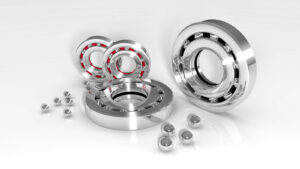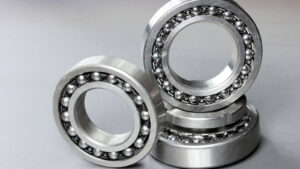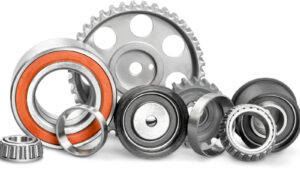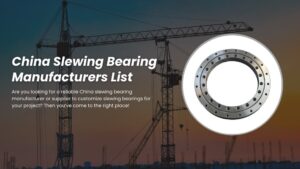In the fields of heavy machinery, wind power generation, engineering equipment, etc., slewing bearings are one of the core components, and their quality and stability are directly related to the safe operation of the equipment. Therefore, it is crucial to choose a reliable slewing bearing manufacturer. Procurement personnel are not only concerned about the quality standards of the products, but also need to pay attention to key factors such as delivery cycle, cost control and after-sales service. So, how to formulate a scientific and reasonable procurement strategy to ensure the stability of the supply chain and reduce procurement risks?
Next, we will analyze the key points of efficient procurement in detail from aspects such as supplier screening, technical parameter evaluation, quality certification and cooperation model.
Clarify Procurement Needs and Choose High-Quality Manufacturers
✅ 1. How to choose a reliable slewing bearing manufacturer?
High-quality manufacturers can provide stable product quality, on-time delivery and perfect technical support. When choosing, you can consider the following aspects:
Qualification certification:
- Make sure the supplier has international quality management system certification such as ISO 9001.
- Check whether it has industry standard certifications, such as API, CE or SGS, etc., to meet the application requirements of specific industries.
Production experience and technical strength:
- Choose a manufacturer with many years of production experience and mature manufacturing processes for slewing bearings of different specifications and models.
- Understand its technological innovation capabilities and whether it has the strength to develop and improve products to meet special project requirements.
Customer reputation and cases:
- Check the supplier’s cooperation cases, especially the cooperation records with well-known companies.
- Learn about its product quality, after-sales service, etc. through customer reviews or third-party platforms.
✅ 2. What key factors will affect procurement quality?
During the procurement process, ensuring product quality is the top priority, and the following factors are crucial:
Material selection and processing technology:
- Ensure that the slewing bearing uses high-quality alloy steel or raw materials that meet industry standards to improve wear resistance and load-bearing capacity.
- Processing accuracy directly affects the performance and service life of the bearing, so it is necessary to confirm whether the manufacturer’s processing technology meets industry standards.
Detection and testing links:
- Whether the supplier has a complete quality inspection system, including size inspection, hardness test, load-bearing test, etc.
- Requires to provide a test report to ensure that the product meets the design parameters and industry standards.
Lubrication and anti-corrosion treatment:
- Pay attention to the perfection of the bearing lubrication system to avoid early failure of the bearing due to improper lubrication.
- Understand whether the supplier provides anti-corrosion treatment to extend the service life of the bearing in harsh environments.
✅ 3. How to optimize procurement costs and delivery cycles?
Effective cost control and delivery cycle management are the key to ensuring the smooth progress of the project.
Cost optimization:
- Bulk purchase discount: Reduce unit price and save procurement costs through large-volume orders.
- Supply chain integration: Choose a manufacturer with one-stop production capabilities to reduce intermediate links and improve cost performance.
Delivery cycle control:
- Delivery commitment: Confirm that the supplier has stable production capacity and negotiate a reasonable delivery time based on project requirements.
- Inventory management: Establish long-term cooperative relationships with suppliers and prepare in advance to cope with unexpected demand.
Flexible cooperation model:
- Understand whether the supplier supports customized services, sample testing and small batch production, and prepare for subsequent large-scale purchases.

Clarify Procurement Needs: Refine Specifications and Technical Requirements
1. Bearing type and application scenarios
Different types of slewing bearings have their own technical characteristics and are suitable for different application scenarios.
Single-row four-point contact ball bearing
- Features: Compact structure, flexible rotation, able to withstand axial, radial and overturning moments.
- Application: Suitable for light mechanical equipment, such as packaging machinery, food processing equipment, etc.
Double-row ball bearing
- Features: Stronger load-bearing capacity, suitable for equipment with large load-bearing requirements.
- Application: Commonly used in engineering machinery, lifting equipment and transportation systems.
Crossed roller bearing
- Features: High precision, strong rigidity, and can provide excellent load-bearing capacity in a limited space.
- Application: Mainly used in high-precision equipment such as robots, industrial automation, and precision machine tools.
2. Size and load-bearing capacity
Accurate size and load-bearing capacity directly determine the service life of the bearing and the stability of the equipment.
Key size parameters:
- Inner diameter and outer diameter: The size of the equipment shaft and the mounting seat must be matched to ensure a close fit.
- Thickness: According to the spatial structure of the equipment, choose the appropriate thickness to prevent interference or installation difficulties.
- Bolt hole position and number: Confirm the position, hole diameter and number of the mounting holes to meet assembly requirements.
Load capacity assessment:
- The bearing needs to have sufficient static and dynamic load capacity, and select the appropriate bearing type and structure according to the application scenario.
- Pay special attention to the bearing capacity of the overturning moment to ensure stable operation of the equipment.
3. Materials and surface treatment
High-quality materials and surface treatment technology can significantly improve the durability and protection performance of the bearing.
Material selection:
- Alloy steel: High-strength alloy steel such as 42CrMo and 50Mn are used, which have good load capacity and wear resistance.
- Stainless steel: Suitable for special environments with anti-corrosion requirements, such as marine equipment or chemical machinery.
Surface hardening treatment:
- Quenching treatment: Improve the hardness and wear resistance of the bearing surface to prevent surface wear caused by long-term operation.
- Carburizing treatment: Further enhance the fatigue resistance of the bearing surface and extend the service life.
- Anti-corrosion coating: Suitable for outdoor or high-humidity environments, anti-corrosion spraying or galvanizing can be selected.
4. Accuracy level and lubrication requirements
Precisely controlling the accuracy level and lubrication conditions of the bearing can significantly improve the stability of equipment operation.
- Accuracy standard: Select the accuracy level (such as P5, P4, etc.) according to ISO or JB/T standards to ensure accurate equipment operation.
- Lubrication requirements: Select appropriate grease or lubricating oil to prevent dry friction under high load and extend bearing life.
Screening manufacturers: examining supply chain capabilities and qualifications
1. Certification and Qualification
High-quality manufacturers should have internationally recognized certification qualifications to ensure that the production process meets industry standards.
- ISO 9001: Ensure that the company has a complete quality management system to improve product consistency and reliability.
- CE certification: Prove that the product meets EU market safety standards and is suitable for export to Europe and the United States.
- API certification: It is crucial for the oil and gas industry. Bearings that meet the standards of the American Petroleum Institute (API) are more competitive in the market.
- Industry-specific certification: Certification for special industries such as wind power, ports, and ships further ensures the applicability of products.
2. Production equipment and technical strength
Advanced production equipment and mature processing technology can ensure the stability of large-scale production and the precision of bearings.
Automation equipment:
- Introduce CNC machining centers (CNC) and automatic heat treatment equipment to improve production efficiency and precision.
- Automated detection system reduces manual errors and ensures product consistency.
Heat treatment process:
- Improve the wear resistance and service life of bearings through heat treatment methods such as carburizing and quenching.
- Pay attention to whether it has the ability to accurately control hardness and strength to meet the needs of different working conditions.
Testing methods:
- Equipped with advanced testing instruments, such as ultrasonic flaw detection, magnetic particle detection, dimensional accuracy testing, etc., to ensure that the products shipped meet strict quality standards.
3. R&D and innovation capabilities
Manufacturers with independent R&D capabilities can provide customers with customized solutions to meet special application needs.
- Customized design capabilities: Ability to develop slewing bearings of specific specifications according to different usage scenarios, such as oversized bearings, lightweight design, special materials, etc.
- Technological innovation: A technical team with continuous innovation can provide improvement solutions in materials, structural design, lubrication systems, etc. to improve the overall performance of bearings.
- Patented technology: Pay attention to whether the manufacturer has relevant technical patents to further enhance the added value and competitiveness of the product.
4. Cases and industry experience
Rich industry experience and successful cases are important manifestations of the manufacturer’s technical strength and market reputation.
Industry coverage:
- Wind power industry: Need to cope with high-load and long-life working environments.
- Oil and gas: Bearings are required to be resistant to high temperatures and corrosion.
- Ships and ports: Pay attention to the seismic resistance and stability of bearings.
Market reputation:
- Understand the manufacturer’s past cooperative customers, especially the cooperation records of internationally renowned companies.
- Check customer reviews and market feedback to evaluate the manufacturer’s performance in service, delivery and technical support.
5. Supply chain management and delivery guarantee
A stable supply chain system is a key factor in ensuring the timely delivery of large-volume orders.
- Raw material supply: Pay attention to the manufacturer’s raw material supply chain to ensure a stable supply of key components.
- Inventory management: Have a complete inventory management system to cope with emergency orders and sudden demands.
- Logistics guarantee: Have an efficient logistics partner to ensure that products are delivered to global customers on time.
To learn more about slewing bearing manufacturers, click this article

Procurement Strategy: Controlling Costs and Improving Supply Chain Efficiency
1. Bulk purchasing and cost optimization
Through a reasonable bulk purchasing strategy, the unit cost can be effectively reduced and the stability of the supply chain can be improved.
✅ Long-term contract to lock in price
- Establishing a long-term cooperative relationship with core manufacturers will help to obtain more favorable prices.
- Avoid the risk of raw material price fluctuations through fixed price agreements.
✅ Demand forecasting and procurement plan
- Combining historical data and market demand, formulate an accurate procurement plan to avoid blind stocking.
- Adopt a batch procurement strategy to balance inventory turnover speed and reduce inventory management costs.
2. Multi-supplier cooperation strategy
Choosing multiple suppliers for cooperation can effectively reduce supply risks and improve bargaining power.
✅ Avoid single supplier risks
- Establish a cooperation mechanism with 2-3 alternative suppliers and switch quickly in case of emergencies.
- Supplier diversification can avoid delivery delays caused by interruptions in a single supply chain.
✅ Bidding mechanism to improve transparency
- By introducing a bidding mechanism, obtain the most competitive prices and enhance suppliers’ quality awareness.
- Supervise the delivery capabilities and product quality of each supplier to ensure compliance with contract requirements.
3. Supply chain collaboration and inventory management
Reasonable supply chain collaboration and inventory management can effectively reduce inventory backlogs and improve overall operational efficiency.
✅ JIT (Just-In-Time) procurement model
- Through the JIT model, key materials are purchased only when needed to reduce inventory backlogs.
- Ensure that key parts arrive on time and improve production flexibility and efficiency.
✅ Supply chain management system
- Establish a complete supply chain management system to achieve real-time monitoring of supplier delivery.
- Predict demand changes through data analysis, adjust procurement plans in a timely manner, and avoid out-of-stock or inventory backlogs.
4. Comparative analysis of cost control and supply chain
The following are the key factors for optimizing procurement strategies and the comparison of different solutions:
| Key Factors | Single Supplier Model | Multiple Supplier Model |
|---|---|---|
| Cost Control | Limited bargaining power, high price fluctuation risk | Better prices through bidding mechanism |
| Supply Chain Flexibility | Concentrated risk, higher impact in case of disruption | Reduced risk, more flexibility with multiple suppliers |
| Delivery Stability | Relies on single supplier’s delivery capability | Guaranteed on-time delivery through multiple sources |
| Quality Control | Quality standards remain consistent | Improved quality through competitive comparison |
| Emergency Handling | Slow response to unexpected situations | Faster response by switching to alternative supplier |
Quality Control: Ensuring Product Stability and Consistency
1. Raw material inspection and traceability
Ensure product quality from the source. Tracing the source of raw materials is the first step to control risks.
- Material test report: Manufacturers are required to provide raw material test reports, including data such as chemical composition and mechanical properties.
- Raw material traceability: Ensure that key raw materials (such as steel, plastic particles, textile fibers, etc.) meet international industry standards and have a complete traceability system.
- Supplier evaluation: Establish a strict raw material supplier access mechanism and regularly review the supplier’s qualifications and production capacity.
| Inspection Item | Target Standard | Supplier Requirement |
|---|---|---|
| Chemical Composition | Complies with ASTM/ISO Standards | Provide Origin Certification |
| Physical Properties | Tensile Strength, Hardness Test | Submit Regular Test Reports |
| Environmental Requirements | ROHS, REACH Certification | Non-toxic, Eco-friendly Materials |
2. Process Quality Control (PQC)
Strict quality control during the production process is an important part of ensuring product consistency.
- Online size detection: Establish an automated size detection system in key processes (such as cutting, sewing, and stretching) to ensure that product specifications meet design requirements.
- Hardness test and tensile test: Perform periodic tensile tests and hardness tests during the production process to ensure that the elasticity and wear resistance of the product meet the standards.
- Key process monitoring: Establish an online monitoring mechanism for heat treatment, quenching, precision machining and other links to prevent process deviations from affecting the final product.
| Key Process | Quality Control Measures | Target |
|---|---|---|
| Cutting & Processing | Online Dimension Detection | ±0.5mm Tolerance |
| Heat Treatment | Real-time Temperature Monitoring | Avoid Insufficient Hardness |
| Tensile Test | Regular Tensile Test | Ensure Rebound Rate ≥ 95% |
3. Factory inspection and third-party testing
Strict product testing is carried out before delivery, and third-party testing is introduced to ensure that the products meet the contract standards.
- Dynamic and static load test: Test the stability and durability of the product under different load conditions.
- Appearance inspection: Observe the flatness, color difference and surface defects of the elastic band to ensure that it meets the customer’s visual requirements.
- Third-party regular sampling inspection: Introduce third-party testing agencies (such as SGS, TÜV) to conduct regular sampling inspections on batch products to ensure long-term stable product quality.
| Inspection Item | Testing Method | Judgment Standard |
|---|---|---|
| Tensile Strength | Tensile Test | ≥ 95% Rebound Rate |
| Load Test | Dynamic/Static Load Test | No Breakage |
| Appearance Quality | Manual and Automatic Inspection | Surface Without Defects |
4. Quality improvement and continuous optimization
On the basis of ensuring quality standards, establish a continuous optimization mechanism to continuously improve product competitiveness.
- Customer feedback tracking: Regularly collect customer feedback and adjust the production process in a timely manner.
- Process optimization and improvement: Identify quality bottlenecks through data analysis and continuously optimize the production process.
- Supply chain quality audit: Regularly review supply chain partners to ensure that upstream and downstream supply links meet standards.
Delivery Cycle and Service Guarantee: Ensuring Supply Chain Stability
1. Delivery cycle management: avoid production delays
Clarify the supplier’s delivery cycle and plan the production schedule reasonably to effectively avoid delivery risks.
Delivery cycle assessment:
- Standard cycle: The general delivery cycle is 4-8 weeks, and the specific time depends on the order size and customization requirements.
- Urgent order processing: Understand whether the supplier has the ability to expedite production to cope with sudden order needs.
Set buffer time:
- Set a 1-2 week safety buffer period for the production cycle to cope with possible production or logistics delays.
- In key projects, it is recommended to sign a delivery guarantee agreement with the supplier to clarify the liability for breach of contract.
Logistics and customs clearance coordination:
- Choose suppliers with rich international logistics experience to ensure smooth cross-border transportation.
- Handle customs clearance procedures in advance to avoid affecting the delivery schedule due to customs clearance issues.
2. After-sales service and technical support: Quick response to ensure production operation
Choose manufacturers that provide professional after-sales service and technical support to quickly solve problems with equipment or products and avoid production stagnation.
Technical support:
- 24/7 technical support: Give priority to suppliers that provide 24/7 technical support to ensure that you can get help quickly when the equipment fails.
- Remote assistance and training: Whether the supplier provides remote diagnosis and operation training to improve the emergency response capabilities of the production team.
Warranty guarantee:
- Require suppliers to provide a 12-24 month warranty period, covering product quality, material defects and manufacturing problems.
- Clearly define the scope of warranty and confirm the service terms of free repair and replacement during the warranty period.
Spare parts supply and maintenance:
- Understand the supplier’s spare parts inventory to ensure that key components can be replaced quickly and reduce downtime.
- Provide long-term maintenance plans to ensure stable operation of equipment.
3. Supply chain stability: Reduce potential risks
Choosing suppliers with stable supply chain management capabilities will help reduce delivery and quality risks.
- Multi-channel raw material procurement: Suppliers should have multi-channel raw material supply capabilities to avoid production interruptions due to raw material shortages.
- Production base distribution: Understand the supplier’s production layout in different regions to prevent delivery from being affected by restrictions on a single factory.
Risk Control: Reduce Procurement and Use Risks
1. Price fluctuations and raw material risks
The fluctuations in raw material prices will directly affect the cost of elastic bands, especially the fluctuations in the prices of raw materials such as rubber and polyester, which may lead to a significant increase in production costs.
✅ Solution:
- Sign a long-term procurement agreement: Establish a stable cooperative relationship with suppliers, lock in raw material prices through long-term agreements, and reduce the uncertainty caused by market price fluctuations.
- Batch procurement strategy: Purchase raw materials in batches according to market conditions to avoid the high risks brought by one-time procurement.
- Select high-quality suppliers: Select suppliers with a stable source of raw materials to effectively avoid sudden cost increases.
2. Technical risks
The backwardness of elastic band production processes and equipment may lead to unstable product quality, reduced production efficiency, and even equipment failure, affecting the delivery cycle.
✅ Solution:
- Supplier technology evaluation: Regularly inspect the supplier’s production equipment and technical level to ensure that it has the ability to continuously update technology.
- Continuous technical improvement: Select manufacturers with R&D capabilities to ensure continuous optimization of production processes and improve product quality and production efficiency.
- Equipment maintenance and upgrade: Require suppliers to formulate regular equipment maintenance plans to prevent production interruptions due to equipment aging.
3. Supply Chain Interruption Risk
Supply chain interruption is a major hidden danger faced by enterprises. Natural disasters, traffic obstructions, policy changes and other factors may cause supply chain breaks and affect production progress.
✅ Solution:
- Establish emergency supplier alternatives: Pre-screen 2-3 alternative suppliers. When the main supplier cannot deliver, the supplier can be quickly switched to ensure production continuity.
- Decentralized procurement strategy: Allocate purchase orders to suppliers in different regions to reduce the risk of supply interruption due to the impact of a certain area.
- Stock safety reserve: Establish a reasonable safety stock to ensure that key materials or products have sufficient reserves to cope with emergencies.
4. Quality risk
The stability of product quality is directly related to the performance and market reputation of the final product. Therefore, reducing quality risks is the core link to ensure product qualification.
✅ Solution:
- Implement strict quality inspection process: Develop a multi-stage quality inspection plan, including raw material inspection, production process monitoring, finished product testing, etc.
- Third-party quality certification: Select suppliers with international certifications (such as OEKO-TEX, ISO, etc.) to ensure that products meet relevant standards.
- Regularly audit suppliers: Evaluate suppliers’ production management and quality control levels through regular audits to identify potential quality risks in a timely manner.
Summary: Scientific Procurement to Create an Efficient Supply Chain
By formulating a reasonable slewing bearing procurement strategy, you can effectively reduce procurement costs, ensure stable product quality, and improve supply chain flexibility. Procurement managers should focus on selecting manufacturers with complete qualifications and strong technology, and combine bulk procurement, inventory management and supply chain collaboration strategies to achieve the optimal configuration of the procurement process.
👉 Contact high-quality slewing bearing manufacturers now to get accurate quotes and improve equipment reliability!





